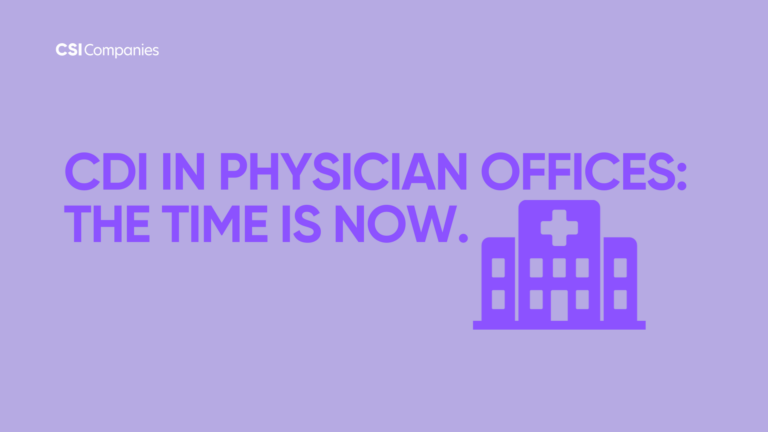CDI in Physician Offices: The Time is Now.

Clinical documentation improvement is the process of ensuring the accuracy and timeliness of patient documentation, which effectively tells a unique story. This story is conveyed through structured coded data. In the physician’s office, code assignment is completed by the physician. The advancement of electronic health records (EHRs) has allowed physicians the flexibility to perform these functions. While this sounds great, it often eliminates any interaction between CDI specialists and coders at the time of coding. In addition, CDI and coding have been primarily considered inpatient acute care functions.
This elimination or rare interaction between a physician, CDI specialists, and coders has led physicians to take on the responsibility of examining, treating, and billing for their patient visits. Rarely is the CDI staff allowed to interact with the physician before billing. This approach is just not going to work in the physician’s office anymore.
So Why the Change?
It has to do with the way reimbursement occurs. Medicare Merit-Based Incentive Programs (MIPS) introduced reimbursement methodologies that are impacting physician offices more than ever before. And we all know that where Medicare goes, other payers will follow. The cost resource category in the MIPS program became effective in 2021 and it continues to have a large impact on physician reimbursement. It is a claims-based reimbursement model that relies on the resources required for patient treatment and the patient’s level of acuity, as reflected in the initial claim. If diagnoses and charges are not correct on the initial claim, filing an amended claim will not help. Physicians need assistance in assigning accurate and timely codes.
The Challenges
There are several challenges to implementing CDI in physician offices including charge entry, appropriate staff, EHR diagnostic code issues, and lack of physician understanding of the coding guidelines. Charge entry or “charge passing” occurs when the physician “clicks on” or “chooses” CPT codes during the office visit. If the physician misses a CPT code (e.g., administration of flu vaccine) the charge is also missed. If the incorrect E/M code is chosen, the patient’s visit does not appear to be as complex as it is. Superbills are also used, requiring someone other than the physician to perform data entry of the CPT codes and ICD-10-CM diagnostic codes who are not always trained in coding. In addition, it is quite uncommon for CDI or coding professionals to review every single physician claim before the billing process. Typically, their attention is directed towards specific areas of focus, such as Diabetes. As a result, other claims are often submitted without a thorough review, which could result in the omission of crucial information.
Another challenge is that most physician offices do not have certified coders or CDI specialists in place. As coders, we are trained to look at what is there. If it’s not documented, it’s not done. CDI specialists are trained to look at what is NOT documented, thus identifying gaps in the patient’s story. Not having these individuals in place within a practice can lead to errors in documentation and claims data. Physicians are typically not trained to document under coding guidelines. Collaborating with a CDI specialist can help identify any gaps in documentation and promote a proactive approach to enhancing accuracy. Investing in the current staff to allow for additional training on CDI is one way to overcome this problem.
EHR system diagnosis coding issues occur when a shortcut or drop-down list is used to assign the ICD-10-CM diagnosis code, as well as the evaluation and management (E/M) code. Knowing the full description of the ICD-10-CM diagnosis is paramount in determining appropriate coding and specificity. For example, if a physician is routinely assigning the code for Myocardial Infarctions (I21) when they mean the history of Myocardial Infarction (I25.2), the patient’s story is distorted, as well as the patient’s risk adjustment score. When using this type of EHR enhancement it is important to use the codes appropriate to the physician group. For example, in a large orthopedic practice, those physicians may not see many pregnant patients. Those ICD-10-CM codes code could be removed from the diagnostic shortcuts.
Diagnostic clinical coding guidelines do not always make sense to physicians. For example, a patient with hypertension and chronic kidney failure requires a combination code. First, a coder assigns I12 for hypertensive kidney disease. ICD-10-CM assumes a cause-and-effect relationship between hypertension and chronic kidney disease. Physicians may find this confusing; these guidelines are not always built into the EHR. Physicians often feel that the EHR system should be responsible for handling these types of scenarios for them. Another example is the ever-changing requirements for E/M levels. Physicians must understand why the appropriate code matters and how that data is used by payers and for quality measures.
The Partners You Need
At CSI, we perform CDI assessments at the elbow of the physicians to determine how we can assist in adjusting their workflow or processes to make the biggest impact. We know that the physician’s first responsibility is to their patients. Let us help you perform at your best. Visit csicompanies.com to learn more about our solutions.

Lou Ann Wiedemann
Director of Provider Coding Operations